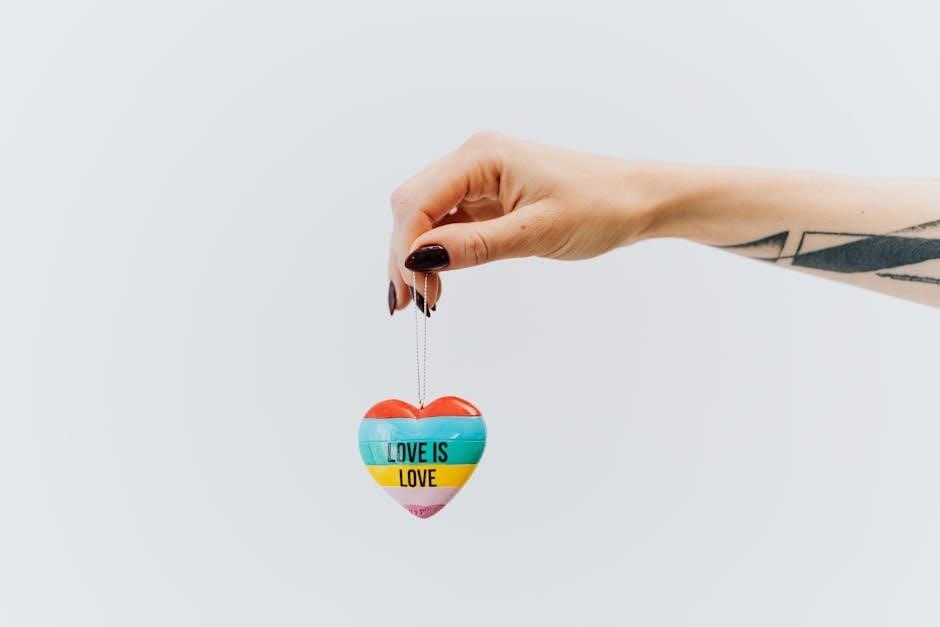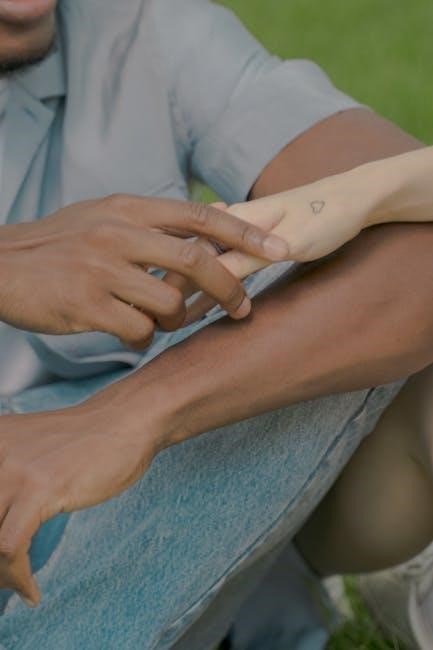tattoos of the heart pdf
Explore the profound journey through Tattoos on the Heart, a book by Gregory Boyle, delving into kinship, redemption, and the significance of tattoo removal for the homies.

Understanding the Title and Its Significance
The title Tattoos of the Heart symbolizes the indelible marks left by human experiences, love, and resilience. It reflects the stories of individuals, particularly those associated with Homeboy Industries, who have undergone transformation through tattoo removal and redemption. The phrase “tattoos of the heart” metaphorically represents the emotional and spiritual imprints that shape our lives. Father Gregory Boyle uses this title to emphasize the power of compassion and kinship in healing societal wounds. The book serves as a testament to the enduring impact of unconditional love and the human capacity for change. By exploring these themes, the title underscores the deeper significance of tattoos as more than just physical art—they are symbols of identity, struggle, and hope.

The Purpose of Tattoo Removal for the Homies
Tattoo removal for the homies serves as a transformative process, enabling individuals to shed visible reminders of their past affiliations and identities tied to gangs. By erasing these marks, Homeboy Industries provides a pathway for reintegration into society, fostering hope and renewal. The removal process symbolizes liberation from cycles of violence and oppression, allowing individuals to reclaim their lives and redefine their futures. This act of compassion empowers them to break free from stigmatizing labels, embracing a new sense of self-worth and belonging. Tattoo removal becomes more than a physical change—it’s a profound step toward healing, identity transformation, and the pursuit of a dignified life, aligning with the book’s themes of kinship and redemption.

Themes and Messages in Tattoos of the Heart
Tattoos on the Heart explores themes of kinship, redemption, and unconditional love, highlighting the transformative power of compassion and human connection in overcoming adversity.
Kinship and Redemption as Central Themes
At the core of Tattoos on the Heart, kinship and redemption emerge as powerful themes. The book, written by Gregory Boyle, S.J., shares stories of individuals connected through shared struggles and hope. Boyle’s work with Homeboy Industries illustrates how forming strong bonds can lead to transformative redemption. The narratives highlight how kinship, often found in unexpected places, becomes a catalyst for healing and personal growth. Through these stories, Boyle underscores the idea that redemption is not only personal but also communal, achieved through collective support and understanding. This theme resonates deeply, showing that human connection can overcome even the most daunting challenges, fostering a sense of belonging and purpose.
Unconditional Love and Compassion

Tattoos on the Heart embodies the transformative power of unconditional love and compassion. Gregory Boyle’s work with marginalized individuals, particularly through Homeboy Industries, reveals how unwavering care can change lives. The book illustrates that true compassion transcends judgment, offering hope to those often dismissed by society. Boyle’s approach emphasizes that love, in its purest form, is not conditional on merit but is freely given, fostering resilience and dignity. This theme is central to the book’s message, demonstrating that compassion is not just an emotion but a catalyst for healing and transformation. Through stories of struggle and redemption, Boyle shows how unconditional love can break cycles of despair, inspiring individuals to find their inherent worth and purpose.

Historical Context of Heart Tattoos
Heart tattoos have evolved over centuries, reflecting cultural and symbolic meanings. From Celtic designs to Chinese motifs, they represent love, loyalty, and spiritual connections across civilizations.
Evolution of Heart Tattoos Through the Ages
Heart tattoos have undergone a remarkable transformation across centuries, reflecting shifting cultural and symbolic meanings. Ancient civilizations, such as Egyptians and Phoenicians, used heart imagery in religious and spiritual contexts. During the Middle Ages, heart symbols appeared in religious art, often representing divine love. The Renaissance period saw hearts incorporated into elaborate designs, blending artistry with symbolism. By the 19th and 20th centuries, heart tattoos became popular among soldiers and sailors, symbolizing love for homeland and family. The 1960s counterculture movement embraced hearts as expressions of peace and love. Today, heart tattoos are deeply personal, often combining traditional and modern elements, such as intricate details or color gradients, to convey unique stories and emotions. This evolution highlights the enduring appeal of the heart as a universal symbol of connection and devotion.
Cultural Significance of Heart Tattoos
Heart tattoos hold profound cultural significance, transcending their aesthetic appeal to represent deep emotional and spiritual values. In many cultures, the heart symbolizes love, courage, and resilience. For instance, in Latin American culture, heart tattoos often signify passion and loyalty, while in Celtic traditions, they represent eternal love and spiritual connection. In Japanese culture, hearts are sometimes paired with waves or dragons, symbolizing strength and harmony. Across different societies, heart tattoos are also used to honor loved ones, commemorate life events, or express personal beliefs; Their universal appeal lies in their ability to convey complex emotions simply, making them a timeless and meaningful choice for individuals worldwide.

Design and Artistry in Tattoos of the Heart
Heart tattoos blend creativity with emotional depth, featuring intricate details like arrows, roses, or names. Artistic techniques vary, from minimalist outlines to vibrant, realistic designs.
Traditional vs. Modern Heart Tattoo Designs
Traditional heart tattoos often feature bold lines, vibrant colors, and classic symbols like roses or arrows, reflecting timeless designs rooted in tattoo culture. These designs emphasize simplicity and enduring appeal, frequently associated with sailor or vintage aesthetics. In contrast, modern heart tattoos incorporate intricate details, abstract patterns, and personalized elements, showcasing advancements in tattoo artistry. Modern designs may blend realism with creativity, offering unique interpretations that cater to individual preferences. While traditional hearts remain popular for their nostalgic charm, modern designs attract those seeking contemporary and bespoke art. Both styles allow wearers to express love, passion, or personal journeys, making heart tattoos versatile and meaningful across generations.
Unique Design Elements and Symbolism
Heart tattoos often incorporate unique design elements that add depth and personal significance. Common symbols include wings, representing freedom or protection, and arrows, signifying love or sacrifice. Flames may encircle the heart, symbolizing passion or transformation. Some designs feature sacred geometry or celestial patterns, blending spirituality with tradition. Personal elements, such as names, dates, or meaningful quotes, are frequently integrated to honor loved ones or commemorate life events. Cultural influences also play a role, with Celtic knots or tribal motifs adding distinctive flair. These elements transform the heart tattoo into a personalized narrative, reflecting individual journeys and emotions. The combination of universal and bespoke symbolism makes each heart tattoo a one-of-a-kind piece of art.

Symbolism and Meaning Behind Heart Tattoos
Heart tattoos symbolize love, resilience, and spirituality, often representing emotional depth and personal transformation. They embody universal themes of connection, hope, and the human experience.
Heart Tattoos as Symbols of Love and Devotion
Heart tattoos are profound symbols of love and devotion, often representing deep emotional connections and unwavering commitment. They can signify romantic love, familial bonds, or self-love, serving as lasting reminders of cherished relationships. In Gregory Boyle’s context, these tattoos embody the transformative power of love and compassion, highlighting how it can heal and redeem. Many designs incorporate elements like arrows, flames, or names, reinforcing their sentimental value. For those who wear them, heart tattoos are more than art—they are testaments to the enduring strength of love, inspiring hope and resilience in the face of adversity. Their beauty lies in their ability to capture the essence of the human spirit’s capacity for connection and devotion.
Heart Tattoos and Their Connection to Spirituality
Heart tattoos hold profound spiritual significance, often symbolizing divine love, inner peace, and connection to a higher power. In many spiritual traditions, the heart represents the seat of the soul, embodying compassion, grace, and transcendence. For some, these tattoos serve as reminders of spiritual journeys or acts of faith, while for others, they signify unity with the universe or divine guidance. The heart’s universal appeal allows it to transcend cultural and religious boundaries, becoming a sacred symbol of spirituality. Many individuals choose heart tattoos as a way to express their devotion or to embody spiritual principles like forgiveness, humility, and unconditional love. This connection to spirituality makes heart tattoos not just decorative but deeply meaningful and transformative.

Cultural Significance of Tattoos of the Heart
Heart tattoos hold diverse meanings across cultures, symbolizing love, spirituality, and identity. They deeply reflect societal values and traditions, often used historically to signify status or devotion.
Heart Tattoos in Different Cultures
Heart tattoos carry profound cultural significance worldwide, reflecting diverse traditions and meanings. In Japanese culture, heart tattoos often symbolize loyalty and perseverance, while in Latin American communities, they may represent gang affiliation or religious devotion. Celtic cultures incorporate intricate knotwork in heart designs, signifying eternal bonds and spiritual connections. In many Indigenous cultures, heart tattoos are used in rituals to symbolize life, community, and spiritual harmony. Modern interpretations blend traditional and contemporary elements, making heart tattoos a universal symbol of love, identity, and cultural heritage. Their enduring appeal lies in their ability to transcend borders, adapting to the unique stories and values of each culture they touch.
The Role of Tattoos in Identity Formation
Tattoos play a significant role in shaping personal and collective identity, serving as visual narratives of an individual’s journey, beliefs, and experiences. They act as symbols of belonging, marking affiliation with specific communities or ideologies. For many, tattoos are a form of self-expression, embedding stories of resilience, love, or transformation into their skin. In the context of gangs, tattoos often signify loyalty and status, becoming integral to a person’s identity within that group. However, the process of tattoo removal, as seen in programs like Homeboy Industries, also reflects a shift in identity, symbolizing a break from past affiliations and the embrace of a new, redeemed self. Tattoos, therefore, are not just art but powerful tools in the ongoing process of identity formation and redefinition.
Psychological Impact of Heart Tattoos
Heart tattoos profoundly impact psychology, symbolizing love, resilience, and inner strength. They embody hope and transformation, yet also reflect emotional pain and past experiences, shaping identity deeply.
Emotional and Psychological Benefits of Tattoos
Tattoos, including heart designs, offer profound emotional and psychological benefits. They serve as symbols of personal growth, empowerment, and self-expression, allowing individuals to embraces their identity. Many find tattoos therapeutic, as they provide a sense of control and confidence. Heart tattoos, in particular, often represent love, resilience, and healing, offering comfort during difficult times. They can also act as reminders of overcoming adversity, fostering a sense of pride and accomplishment. Additionally, the process of getting a tattoo can be meditative, promoting mindfulness and emotional release. Overall, tattoos are more than art; they are tools for emotional well-being and psychological transformation, deeply impacting how individuals perceive themselves and their life journeys.
The Therapeutic Aspect of Tattoo Removal
Tattoo removal can have a profound therapeutic impact, especially for individuals seeking to release emotional burdens tied to their tattoos. For many, particularly those with heart tattoos, removal symbolizes liberation from past experiences or relationships that no longer serve them. This process allows for emotional healing and renewal. The act of removing a tattoo can signify personal growth, enabling individuals to reclaim their identity and move forward from painful memories. It also provides closure, helping people disengage from symbols that once held negative connotations. Ultimately, tattoo removal becomes a transformative experience, fostering emotional release and empowerment. It underscores the idea that healing is not just physical but deeply psychological, offering a fresh start and a chance to redefine oneself.
Real-Life Applications of Tattoos of the Heart
Heart tattoos symbolize redemption and empowerment, as seen in Homeboy Industries, where tattoo removal helps individuals reclaim their identities and reintegrate into society, fostering community healing and social justice;
Homeboy Industries and Tattoo Removal
Homeboy Industries, inspired by Father Gregory Boyle’s work, provides free tattoo removal services to former gang members, helping them erase visible reminders of past affiliations. This process symbolizes liberation from cycles of violence and stigma, empowering individuals to rebuild their lives. The organization combines tattoo removal with counseling, education, and job training, fostering holistic transformation. By removing tattoos, Homeboy Industries assists clients in reintegrating into society, breaking barriers to employment and personal growth. This initiative reflects the broader mission of Tattoos of the Heart, emphasizing redemption, dignity, and the human capacity for change. Through this program, Homeboy Industries embodies the book’s themes of compassion and second chances.
Using Tattoos as Tools for Social Justice
Tattoos have become powerful tools for social justice, enabling individuals to express solidarity, raise awareness, and advocate for change. By incorporating symbolic designs, people use their bodies to amplify marginalized voices and challenge systemic injustices. Tattoos like awareness ribbons, equality symbols, or cultural motifs spark conversations and foster empathy. They also serve as permanent reminders of commitment to causes such as racial justice, gender equality, or environmental activism. This form of body art transcends personal expression, becoming a visual statement of collective resistance and hope. Tattoos of the Heart highlights how such artistry can unite communities, inspire action, and promote healing, aligning with the book’s themes of compassion and transformation. They empower individuals to wear their values and beliefs visibly, creating a lasting impact.
Book Analysis: Tattoos on the Heart by Gregory Boyle

Tattoos on the Heart by Father Gregory Boyle is a moving memoir exploring redemption, compassion, and kinship through stories of marginalized youth in Los Angeles.
Tattoos on the Heart by Gregory Boyle delves into the transformative power of unconditional love and compassion. Through heartfelt stories of gang members in Los Angeles, Boyle illustrates the resilience of the human spirit and the possibility of redemption. The book highlights the importance of kinship, emphasizing that everyone deserves dignity and love, regardless of their past. Boyle’s work with Homeboy Industries serves as a backdrop, showcasing how tattoos, often seen as symbols of bondage, can be removed or reinterpreted as signs of liberation and renewal. The author challenges societal perceptions of marginalization, advocating for a world where compassion triumphs over judgment. Boyle’s narratives not only inspire hope but also underscore the universal need for belonging and the transformative impact of radical love.
Father Gregory Boyle’s Approach to Compassion
Father Gregory Boyle’s approach to compassion is rooted in radical kindness and unwavering belief in human dignity. He rejects judgment, instead embracing the inherent worth of every individual, regardless of their past. Boyle’s work with gang members in Los Angeles highlights his commitment to creating a sense of belonging and hope. By offering unconditional love and practical support, such as tattoo removal, he empowers people to redefine their identities. His philosophy centers on kinship, emphasizing that compassion is not about fixing others but about walking alongside them. Boyle’s approach challenges societal norms, advocating for a world where love and understanding replace fear and division. His work exemplifies the transformative power of compassion, proving that even the most marginalized can find redemption and healing.
Tattoos on the Heart concludes with a powerful message of redemption and compassion, showing how tattoo removal symbolizes personal transformation and broader societal healing ultimately.
Final Thoughts on Tattoos of the Heart
The heart tattoo, as explored in Tattoos on the Heart, serves as a powerful symbol of transformation and connection. It transcends its physical form, embodying love, resilience, and redemption. Whether traditional or modern, the heart tattoo carries deep emotional and spiritual weight, reflecting the wearer’s journey and beliefs. Its cultural significance spans generations, adapting to societal changes while retaining its core meaning. For many, it becomes a visual reminder of personal growth, forgiveness, and the enduring power of compassion. The stories shared in the book highlight how tattoos, particularly of the heart, can bridge divides and inspire hope, making them more than just art—they are testaments to the human spirit’s capacity for healing and connection.
The Lasting Impact of Tattoos on the Heart
The tattoos of the heart, as explored in the book Tattoos on the Heart, leave an indelible mark on both individuals and communities. They symbolize resilience, love, and the human capacity to transcend adversity. For many, these tattoos become a permanent reminder of their journey toward redemption and healing. Beyond their aesthetic appeal, they carry profound emotional and spiritual significance, often inspiring others to embrace compassion and kinship. The stories shared in the book highlight how tattoos, particularly those of the heart, can foster a sense of belonging and renewal. Their impact extends beyond the individual, creating ripples of hope and transformation that resonate deeply within society.
